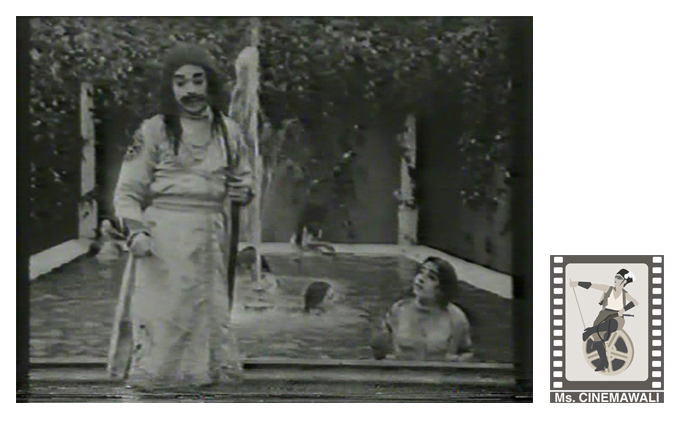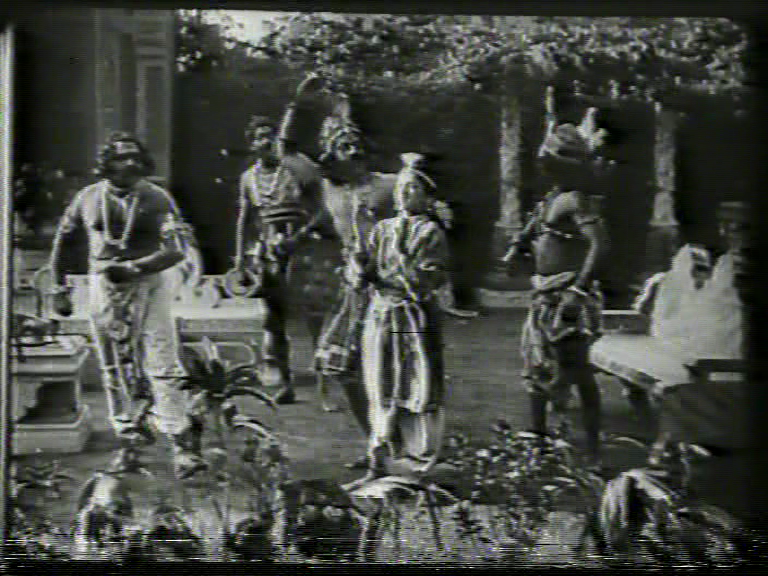About the column: This series presents short articles and photo-essays on the industrial aspects of cinema produced from Bombay aka Bollywood. Stories of the making of Bollywood, stars, publicity mechanisms, fan cultures, gossips, costumes, music usage, playback systems, singers, composers, as well as writings by the players and so on. The film industry, however, will be seen through the pointed glasses of women, intricately linking all the narratives of one ‘Miss Cinemawali’ or the other.
Madhuja Mukherjee revisits the female characters played by the young man Anna Salunke and his contribution to the production, of what is now framed and studied as ‘Early Indian Cinema’.
Anna Salunke, birth-death unknown, was one of the first female ‘stars’ of Indian cinema. As indicated in the bio-pic Harishchandrachi Factory (Directed by Paresh Mokashi, 2009), D. G. Phalke faced countless difficulties as he strove to find appropriate female actors for his first feature-film, Raja Harishchandra (1913). Phalke, eventually, and somewhat accidentally, found a young man – Salunke – who was a cook. Then again, it is crucial to recall that it was not uncommon, especially in traditional theatre, for men to perform female roles.[i] As well, in the early phase of Indian cinema, that actors would perform multiple roles, both on-screen and off-screen, was a somewhat widespread practice. For instance, while remarkable singers like Kanan Bala and M S Subhalaxmi acted out male roles in the early stages of their careers, it is well-known that Sulochana (or Ruby Myers) performed eight characters, including male roles, in the popular silent film Wildcat of Bombay (1927). However, one may assert that Anna Salunke was exceptional. Besides, his performance as the suffering Rani Taramati, in India’s (arguably) ‘first’ feature length film, produced a liminal space for a range of reflections.
Truly, who can forget the scenes in which Rani Taramati tugs her (wet) sari as she listens to the King, and his proposals about hunting, and later her grief stricken expressions as their kingdom is taken away by the angry sage Vishwamitra. Eventually, in the film, Taramati suffers a series of extreme acts of violence, and emerges as a forceful symbol of pain and grief. Moreover, especially crucial is the style, which Salunke (and perhaps Phalke as well) introduced by way of tugging the sari, and by rubbing and hiding the delicate face, as Rani Taramati cries over her fate and the injustice done to her. Curiously, this particular style of performance is repeated in the film Lanka Dahan (1917).
Rani Taramati (Salunke) listens to Raja Harishchandra
Rani Taramati (Salunke) listens to Raja Harishchandra
After Harishchandra is dethroned, Rani Taramati (Salunke) is falsely accused of murder
 Rani Taramati (Salunke) cries over the injustice
Rani Taramati (Salunke) cries over the injustice
 Rani Taramati (Salunke) pleads ‘not-guilty’
Rani Taramati (Salunke) pleads ‘not-guilty’
 Salunke’s classic style as ‘she’ is about to be executed
Salunke’s classic style as ‘she’ is about to be executed
Salunke as Sita in Lanka Dahan, performing in his recognisable style
 Salunke as Sita in Lanka Dahan
Salunke as Sita in Lanka Dahan
Phalke’ s creative superimposition as Sita remembers Ram -also played by Salunke
 Sita (Salunke) receives Ram’s ring through Hamuman
Sita (Salunke) receives Ram’s ring through Hamuman
One must emphasise that, in Lanka Dahan, Salunke got the unique opportunity to perform the epic characters of both Sita and Ram. From the sections of the film, which continue to subsist, it is also apparent that through his involved acting, bodily movements, and expressions Salunke created a style of performance which was recognisable and could be re-enacted, and that he was clearly an evolved actor who could re-present himself remarkably differently as Ram or Sita. In time, Salunke performed female roles in as many as five films, including in Satyanarayan (1922) directed by V.S. Nirantar and Phalke’s Buddha Dev (1923), for which he also did cinematography.
In fact, as the story goes, Salunke ‘developed muscles’ and in due course also developed the skill of cinematography. It may be worthwhile to deliberate on the industrial conditions within which an actor may become a cinematographer, or perform the dual roles of an actor and a cinematographer.[i] Unfortunately, neither much exists of such narratives of progress, nor any document on Salunke’s life is accessible. Nevertheless, precisely because of such lack, one needs to re-collect fragments of lost films and stories. And, it is within such contexts that one remembers Bhakta Pralhad (1926), a film shot by Salunke and directed by Phalke.
While much has been written about the frontal and direct address of early cinemas, as well as about the lateral movement in Phalke’s Raja Harishchandra,[iii] nonetheless, the film that Salunke shot focuses on a certain shift in Phalke’s style of shot taking. While the practice of tableaux as a narrative device continued, Salunke created a defined foreground (with plants for example), and a distinct background, which were often explored through the action of actors and movement. Moreover, the uses of the close-shots demonstrate an emergent style. In reality, Salunke has been credited with as many as thirty-two films as cinematographer, which include films like Jarasandha Vadha (1923), Jayadratha Vadh (1924), Ram Ravan Yuddha (1924), Shivajichi Agryahun Sutaka (1924), Bhim Sanjeevan (1926), Keechaka Vadh (1926), Sant Eknath (1926), Bhakta Sudama (1927), Draupadi Vastraharan (1927), Hanuman Janma (1927),Vasantsena (1929), Amir Khan (1931) etc., most of which were directed by Phalke.
In his interview published in the Indian Cinematograph Committee Report (1927-28, vol. 3, 869-885), D. G. Phalke said the following:
Q. [by the Committee]: Do you think if you improve the quality of Indian films you will have a wider market abroad? Do you think well made Indian films will command a good audience if shown in England?
A. [by Phalke]: Not the present ones produced in India, but well made ones may have audience, I have exhibited some of my own films in England in London [sic] such as Savitri, Harishchandra, and other films and the press in London remarked “ From the technical point of view Phalke’s films are excellent ”.
Q. Did you make money in England by the exhibition of your films there?
A. No.
A. I did not do it in a commercial way. […]
Q. You said you sent your films to Singapore. Had you success there?
A. Yes, it was a success .We have sent films to Singapore, Rangoon and other places.
Q. Have you ever tried to send your films to East Africa?
A. Yes, we have sent some of our films to Zanzibar.
Consequently, let us imagine that films acted in and shot by Salunke were not only widely screened across the world, but probably Salunke had some male and female fans as well. Then again, just as Phalke himself died penniless and was forgotten, who knows what really happened to Salunke after 1931, after the advent of sound, new technologies, as well as renewed styles of filmmaking and industrial settings? Sadly, almost all such films have melted into oblivion, just as Salunke seemingly appears like an empty signifier, signifying something that is absent altogether. Yet, one may argue that Salunke’s contribution in the production of images through his on-screen and off-screen actions shaped a new vista of possibilities, and framed what is now studied as ‘Early Indian Cinemas’.
Bhakt Pralad, shot by Salunke
 Exploring the foreground, mid-ground and background in Bhakt Pralad
Exploring the foreground, mid-ground and background in Bhakt Pralad
The goblet containing the poison, and uses of close-shot in Bhakt Pralad
The poison magically becomes ineffective, presented through close-shots in Bhakt Pralad
_______________________________________________________________________________________________________________























